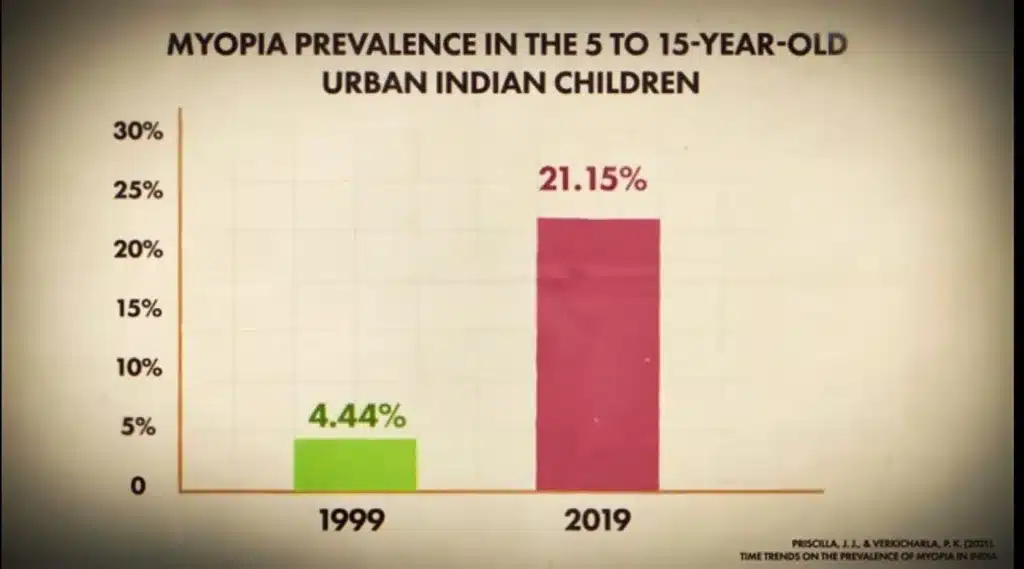The Myopia Epidemic
Hello, friends! Do you remember when you were younger, your parents often told you not to watch TV too much, as it would affect your eyes and you might have to wear glasses? Unfortunately, the truth is evident today—millions of kids are nearsighted, and the prevalence of the myopia epidemic, or nearsightedness, is reaching alarming levels.
Understanding Myopia
1. The Rise of Myopia
In India, the prevalence rate of myopia among kids aged 5-15 has skyrocketed from 4.5% two decades ago to a staggering 21% today. Myopia is now considered an epidemic, and projections indicate that by 2050, almost every individual worldwide will need glasses.

2. How Eyes Work
To comprehend myopia, we must first understand how the human eye functions. The eye operates like a convex lens, where light converges on the retina. The cornea plays a crucial role in bending light, responsible for about 70% of the process.
3. Causes of Myopia
Myopia occurs when the eyeball elongates, causing the focal point to fall in front of the retina. The two leading theories behind myopia are the Near-Work Theory, suggesting prolonged near activities strain the eyes, and the DNA Theory, which attributes myopia to genetics.
4. Near-Work Theory
Historically, the Near-Work Theory gained prominence, linking myopia to activities like reading or screen time. However, recent studies challenge its validity, emphasizing the intensity of sessions rather than overall duration.

5. The DNA Theory
Once believed to be the sole cause, the DNA Theory lost ground when studies revealed significant shifts in myopia rates in a single generation, refuting the hereditary connection.
6. The Outside Theory
The latest scientific theory, the Outside Theory, proposes that spending less time outdoors, and reduced exposure to daylight, is the primary factor driving the surge in myopia among children.
Scientific Studies and Findings
7. Impact of Daylight
Studies have shown a strong correlation between outdoor activities and reduced myopia risk. Exposure to bright light, particularly sunlight, increases dopamine production in the retina, regulating eye growth.
8. Global Initiatives
Countries like China and Singapore have recognized myopia as a significant health concern and implemented measures to address it. Initiatives include encouraging outdoor activities, reducing screen time, and reevaluating educational practices.

Alarming Predictions and Health Risks of Myopia Epidemic
9. Myopia’s Link to Blindness
Contrary to the belief that wearing glasses solves everything, recent studies predict a substantial increase in high-grade myopia, with associated risks of blindness due to retinal tears and detachment.
10. Pandemic’s Impact
The COVID-19 pandemic exacerbated the myopia issue, with increased screen time during lockdowns causing a surge in myopia rates, especially among young children.
Solutions and Preventative Measures
11. Combating Myopia
Addressing myopia requires a multi-faceted approach, considering all three theories. While genetic factors are beyond control, prioritizing outdoor activities and reducing near-work intensity can significantly mitigate myopia risks.
12. Implementing Preventative Measures
Governments and educational institutions worldwide are adopting preventative measures. These include increased outdoor time, reduced screen exposure, and innovative classroom setups to protect children’s eyes.

13. Vision Correction Options
For those already dealing with myopia, vision correction options like LASIK surgery and Orthokeratology lenses exist. However, preventing further progression through lifestyle changes remains crucial.
14. The Role of Sunlight
Ensuring exposure to adequate daylight, with brightness levels around 10,000 lux, is essential. Artificially replicating such brightness indoors is challenging and may not be as effective as spending time outdoors.
Conclusion
In conclusion, myopia is a growing global concern, and addressing it requires collective efforts. Prioritizing outdoor activities, reducing screen time, and understanding the complex interplay of genetic and environmental factors are crucial steps toward a myopia-free future.
FAQs
- Is myopia reversible?
Myopia itself is not reversible, but lifestyle changes can prevent its progression. - What role does genetics play in myopia?
While genetics can contribute, recent studies highlight the significant impact of environmental factors. - Can LASIK surgery completely cure myopia?
LASIK surgery can restore normal vision, but preventive measures are essential to avoid relapse. - Are Orthokeratology lenses safe for long-term use?
Ortho-K lenses are considered safe, but their effects are reversible, requiring consistent use for optimal results. - How can I protect my child from myopia?
Encouraging outdoor activities, limiting screen time, and adopting a balanced lifestyle can help prevent myopia in children.
Share this content:




Post Comment